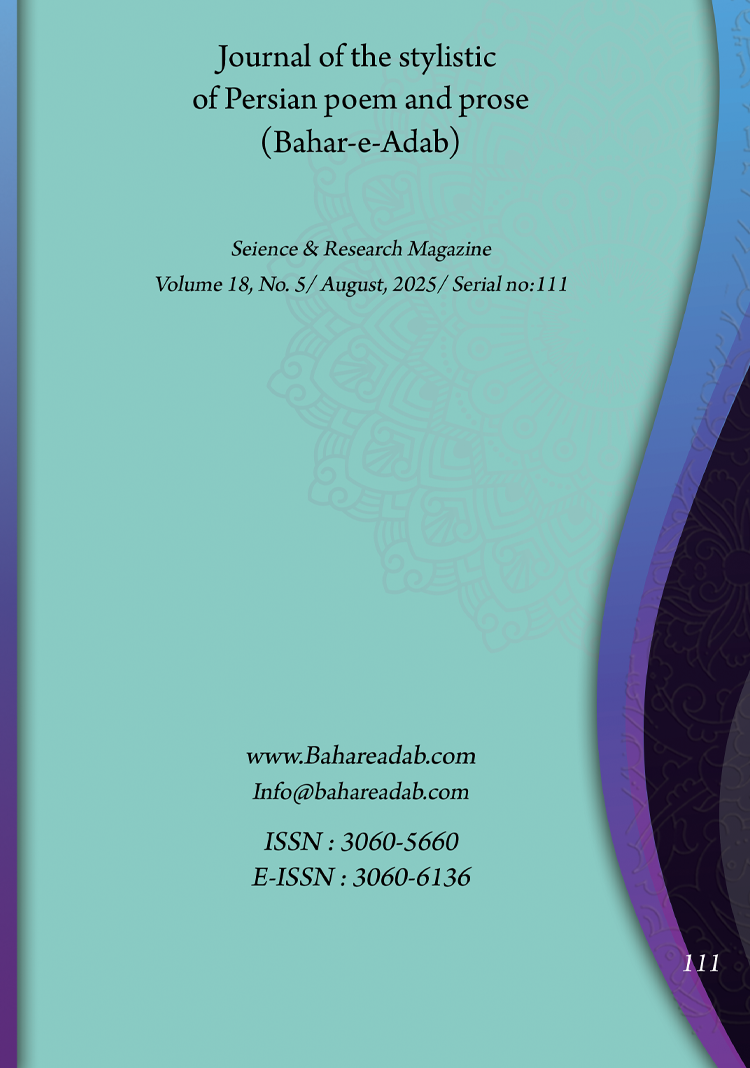- Count View : 16
- آدرس کوتاه شده مقاله: https://bahareadab.com/article_id/1849
- کد doi مقاله: Doi: 10.22034/bahareadab.2025 .18 .7774
Journal of the stylistic of Persian poem and prose
volume Number 18،
number In Volume 5،
،
issue Number 111
Study and Analysis of the stylistic use of Allusion in the poetry of Nadim Qaisari
Hassan Joya , Reza Chehraghani (Author in Charge)
Abstract
BACKGROUND AND OBJECTIVES: Mirza Mohammad Yahya Nadim Qaisari is a contemporary Afghan poet who, like many of his fellow poets, is not well-known in Iran. The exploration and analysis of the diverse facets of Persian poetry in Afghanistan is one of the relatively overlooked areas in our literary community. This research, which aims to analyze the types, breadth, and rhetorical functions of allusion in Nadim’s collection, seeks to examine the extent and varieties of allusion in his poetry by providing samples from Nadim Qaisari’s works.
METHODOLOGY: This study is a theoretical investigation whose data has been gathered from library documents and has been analyzed using a combination of descriptive-analytical and statistical methods (specifying the frequency of each type of allusion). The scope of this research encompasses all poems included in the collected works of Nadim Qaisari, with an introduction by Mohammad Sarvar Molaei, published in 2011 by Erfan Publishing in Tehran.
FINDINGS: The findings reveal that Nadim Qaisari, through the selection of Quranic allusions, religious, mythological, historical, and literary figures, imitates certain characteristics of predecessors but has also introduced innovations in this regard.
CONCLUSION: From the analyses conducted on Nadim’s collected works, it can be concluded that the majority of Nadim Qaisari’s allusions pertain to religious, mythological, historical, and literary figures, serving a rhetorical function of brevity and aimed at persuasion and encouragement.
Keyword
Contemporary Afghan Poetry
, Nadim Qaisari
, Allusion
, Mythological
, Historical and Literary Figures.
- Ahmadnejad, Kamal. (2003). Literary Techniques. Tehran: Fourth Edition. Payam Publishing.
- Pour Namdarian, Taqi (2006). Stories of the Prophets in the Collected Works of Shams. Tehran: Third Edition. Volume One. Institute for Humanities and Cultural Studies.
- Joiri, Mohammad (2005). Collected Stories of the Prophets. Tehran: Tenth Edition. Islamieh Publishing.
- Dad, Sima. (2016). Dictionary of Literary Terms. Tehran: Third Edition. Morvarid Publishing.
- Zanjani, Barat (1984). Summary of the Story of Khosrow and Shirin. Tehran: Third Edition. Amir Kabir Publishing.
- Sajadi, Seyed Jafar (2004). Dictionary of Mystical Terms and Interpretations. Tehran: Seventh Edition. Tahouri Publishing.
- Saidi, Gol Baba (2013). Comprehensive Dictionary of Mystical Terms Based on the Works of Ibn Arabi. Tehran: First Edition. Zavar Publishing.
- Shafiei Kadkani, Mohammad Reza. (2012). The Music of Poetry. Tehran: Thirteenth Edition. Agha Publishing.
- Shamisa, Cyrus. (2010). Dictionary of Allusions. Tehran: Second Edition. Mitra Publishing.
- Shamisa, Cyrus. (2016). A New Look at Rhetoric. Tehran: Sixth Edition. Mitra Publishing.
- Sheikhi, Mojgan (1995). The Story of Layla and Majnun by Nizami Ganjavi. Tehran: First Edition. Ghadiani Publishing.
- Tabari, Muhammad ibn Jarir (1977). Translation of Tabari’s Commentary. Edited by Habib Yaghmaei. Tehran: Volume 7. Tus Publishing.
- Atigh Nishaburi, Abu Bakr (1986). Stories from the Holy Quran derived from the commentary of Abu Bakr Atigh Nishaburi, known as Sourabadi. Edited by Yahya Mahdavi. Tehran: Second Edition. Khwarizmi Publishing.
- Forouzanfard, Badie al-Zaman. (1982). Hadiths of the Masnavi. Tehran: Third Edition. Amir Kabir Publishing.
- Kazaazi, Mir Jalal al-Din. (1994). Aesthetics of Persian Speech (3), Rhetoric. Tehran: Center Publishing.
- Gorganji, Mohammad Hossein. (1998). The Most Wonderful Wonders. Edited by Hossein Jafari, with a preface by Dr. Jalil Tajlil. Tabriz: Ahrar Tabriz Publishing.
- Mohammadi, Mohammad Hossein. (1995). Dictionary of Allusions in Contemporary Poetry. Tehran: First Edition. Mitra Publishing.
- Nadim Qaisari, Mohammad Yahya (1951). Collected Works of Nadim Qaisari. Edited by Mohammad Nasir Gharghest. Kabul: Mosturi Publishing.
- Nadim Qaisari, Mohammad Yahya (2011). Collected Works of Nadim . Edited by Mohammad Sarvar Molaei. Tehran: First Edition. Erfan Publishing.
- Najafgholi, Mirza. (1983). The Pearl of Najafi. Edited by Hossein Ahi. Tehran: Froughi Publishing.
- Nishaburi, Abu Ishaq Ibrahim. (2003). Stories of the Prophets. Edited by Habib Yaghmaei. Tehran: Third Edition. Scientific and Cultural Publishing.
- Nishaburi, Abu Ishaq Ibrahim. (2012). Stories of the Prophets. Edited by Moazzama Mosalli. Tehran: First Edition. Botimar Publishing.
- Va’ez Kashafi Sabzevari, Kamal al-din Hossein. (1990). Badi’ al-Afkar in Poetical Arts. Edited and compiled by Mir Jalal al-Din Kazazi. Tehran: First Edition. Center Publishing.
- Vahidiankamyar, Taqi. (2000). Rhetoric from an Aesthetic Perspective. Tehran: First Edition. Doostan Publishing.
- Homaei, Jalal al-Din. (2010). Techniques of Rhetoric and Literary Devices. Tehran: First Edition. Ahura Publishing.

